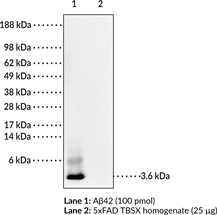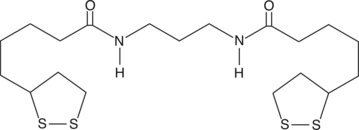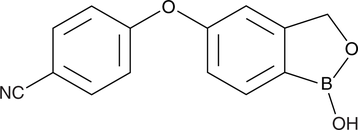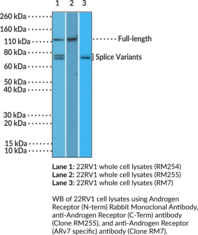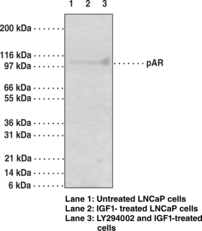Cayman
Showing 9601–9750 of 45550 results
-
Amuvatinib is a multi-targeted inhibitor of receptor tyrosine kinases that inhibits c-Kit, platelet-derived growth factor receptor α (PDGFRα), and c-Met (IC50s = 10, 40, and 81 nM, respectively).{34322} It inhibits growth and induces apoptosis in prostate cancer cell lines, with additive effects achieved when combined with erlotinib (Item No. 10483).{34322} Amuvatinib sensitizes cancer cells to radiation and chemotherapeutic compounds, in part by inhibiting homologous recombination.{29344,34323,34324}
Brand:CaymanSKU:21461 -Out of stock
Amuvatinib is a multi-targeted inhibitor of receptor tyrosine kinases that inhibits c-Kit, platelet-derived growth factor receptor α (PDGFRα), and c-Met (IC50s = 10, 40, and 81 nM, respectively).{34322} It inhibits growth and induces apoptosis in prostate cancer cell lines, with additive effects achieved when combined with erlotinib (Item No. 10483).{34322} Amuvatinib sensitizes cancer cells to radiation and chemotherapeutic compounds, in part by inhibiting homologous recombination.{29344,34323,34324}
Brand:CaymanSKU:21461 -Out of stock
Amygdalin is a cyanogenic glycoside that has been found in seeds from plants of the Rosaceae family and has diverse biological activities.{47285,47286,47287,47288,47289} It induces cell cycle arrest at the G0/G1 phase, decreases cyclin A and Cdk2 levels, and inhibits cell growth in UMUC-3, RT112, and TCCSUP bladder cancer cells when used at concentrations ranging from 1.25 to 10 mg/ml.{47286} Amygdalin (3 mg/kg) reduces the number of primary microtubules and microvessels in aortic rings isolated from rats with diabetes induced by streptozotocin (Item No. 13104).{47287} In vivo, amygdalin reduces triglyceride, total cholesterol, and LDL levels and aortic sinus plaque area in an LDLR-/- mouse model of atherosclerosis.{47288} It also reduces production of TNF-α, IL-1β, and IL-6, as well as neutrophil and macrophage infiltration, in bronchoalveolar lavage fluid (BALF) in a mouse model of LPS-induced acute lung injury.{47289}
Brand:CaymanSKU:26668 - 10 gAvailable on backorder
Amygdalin is a cyanogenic glycoside that has been found in seeds from plants of the Rosaceae family and has diverse biological activities.{47285,47286,47287,47288,47289} It induces cell cycle arrest at the G0/G1 phase, decreases cyclin A and Cdk2 levels, and inhibits cell growth in UMUC-3, RT112, and TCCSUP bladder cancer cells when used at concentrations ranging from 1.25 to 10 mg/ml.{47286} Amygdalin (3 mg/kg) reduces the number of primary microtubules and microvessels in aortic rings isolated from rats with diabetes induced by streptozotocin (Item No. 13104).{47287} In vivo, amygdalin reduces triglyceride, total cholesterol, and LDL levels and aortic sinus plaque area in an LDLR-/- mouse model of atherosclerosis.{47288} It also reduces production of TNF-α, IL-1β, and IL-6, as well as neutrophil and macrophage infiltration, in bronchoalveolar lavage fluid (BALF) in a mouse model of LPS-induced acute lung injury.{47289}
Brand:CaymanSKU:26668 - 25 gAvailable on backorder
Amygdalin is a cyanogenic glycoside that has been found in seeds from plants of the Rosaceae family and has diverse biological activities.{47285,47286,47287,47288,47289} It induces cell cycle arrest at the G0/G1 phase, decreases cyclin A and Cdk2 levels, and inhibits cell growth in UMUC-3, RT112, and TCCSUP bladder cancer cells when used at concentrations ranging from 1.25 to 10 mg/ml.{47286} Amygdalin (3 mg/kg) reduces the number of primary microtubules and microvessels in aortic rings isolated from rats with diabetes induced by streptozotocin (Item No. 13104).{47287} In vivo, amygdalin reduces triglyceride, total cholesterol, and LDL levels and aortic sinus plaque area in an LDLR-/- mouse model of atherosclerosis.{47288} It also reduces production of TNF-α, IL-1β, and IL-6, as well as neutrophil and macrophage infiltration, in bronchoalveolar lavage fluid (BALF) in a mouse model of LPS-induced acute lung injury.{47289}
Brand:CaymanSKU:26668 - 5 gAvailable on backorder
Amygdalin is a cyanogenic glycoside that has been found in seeds from plants of the Rosaceae family and has diverse biological activities.{47285,47286,47287,47288,47289} It induces cell cycle arrest at the G0/G1 phase, decreases cyclin A and Cdk2 levels, and inhibits cell growth in UMUC-3, RT112, and TCCSUP bladder cancer cells when used at concentrations ranging from 1.25 to 10 mg/ml.{47286} Amygdalin (3 mg/kg) reduces the number of primary microtubules and microvessels in aortic rings isolated from rats with diabetes induced by streptozotocin (Item No. 13104).{47287} In vivo, amygdalin reduces triglyceride, total cholesterol, and LDL levels and aortic sinus plaque area in an LDLR-/- mouse model of atherosclerosis.{47288} It also reduces production of TNF-α, IL-1β, and IL-6, as well as neutrophil and macrophage infiltration, in bronchoalveolar lavage fluid (BALF) in a mouse model of LPS-induced acute lung injury.{47289}
Brand:CaymanSKU:26668 - 50 gAvailable on backorder
Antigen: oligomeric form of Aβ42 • Host: mouse • Isotype: IgG2b • Cross Reactivity: (+) human Aβ; unaggregated, oligomeric and fibrillar forms of synthetic Aβ42, and unaggregated Aβ40; (−) human APP • Application(s): WB, ELISA, ICC, and IP
Brand:CaymanSKU:11610- 200 µgAvailable on backorder
Antigen: oligomeric form of Aβ42 • Host: mouse • Isotype: IgG2b • Cross Reactivity: (+) human Aβ; unaggregated, oligomeric and fibrillar forms of synthetic Aβ42, and unaggregated Aβ40; (−) human APP • Application(s): WB, ELISA, ICC, and IP
Brand:CaymanSKU:11610- 200 µgAmyloid plaques composed primarily of the 42 amino acid form of amyloid-β peptide (Aβ42) are a hallmark of Alzheimer’s disease (AD). However, the roles of the various amyloid β peptide(s), especially Aβ42, related to the neurotoxicity characteristic of AD remains unclear. A major hindrance to evaluating the role of Aβ in AD pathology has been the availability of anti-Aβ antibodies to selectively detect Aβ versus amyloid precursor protein (APP), Aβ40 versus Aβ42, and specific conformations of the peptide, particularly oligomeric forms. MOAB-2 (mouse IgG2b) is a pan-specific antibody specific to Aβ (residues 1-4) that differentiates intracellular Aβ from APP. MOAB-2 does not detect APP in cell culture media/lysates or in brain homogenates from transgenic mice expressing 5 familial AD mutation (5xFAD mice). Intraneuronal Aβ was confirmed by co-localization of MOAB-2 immunoreactivity with C-terminal antibodies specific for Aβ40 and Aβ42, and with cathepsin-D, a lysosomal marker. Additionally, MOAB-2 demonstrates strong intraneuronal and extra-cellular immunoreactivity in 5xFAD and 3xTg mouse brain tissues.{20683}
Brand:CaymanSKU:11610 - 200 µgAvailable on backorder
Amylose is a polysaccharide made of α-D-glucose units, bound to each other through α(1→4) glycosidic bonds. It constitutes about 20% of starch, the major storage carbohydrate in plants. It can act as an indicator, turning blue in the presence of iodine, and has also been coupled to magnetic beads for the isolation and purification of maltose-binding protein fusion proteins.{28627,28628}
Brand:CaymanSKU:-Available on backorder
Amylose is a polysaccharide made of α-D-glucose units, bound to each other through α(1→4) glycosidic bonds. It constitutes about 20% of starch, the major storage carbohydrate in plants. It can act as an indicator, turning blue in the presence of iodine, and has also been coupled to magnetic beads for the isolation and purification of maltose-binding protein fusion proteins.{28627,28628}
Brand:CaymanSKU:-Available on backorder
Amylose is a polysaccharide made of α-D-glucose units, bound to each other through α(1→4) glycosidic bonds. It constitutes about 20% of starch, the major storage carbohydrate in plants. It can act as an indicator, turning blue in the presence of iodine, and has also been coupled to magnetic beads for the isolation and purification of maltose-binding protein fusion proteins.{28627,28628}
Brand:CaymanSKU:-Available on backorder
Amylose is a polysaccharide made of α-D-glucose units, bound to each other through α(1→4) glycosidic bonds. It constitutes about 20% of starch, the major storage carbohydrate in plants. It can act as an indicator, turning blue in the presence of iodine, and has also been coupled to magnetic beads for the isolation and purification of maltose-binding protein fusion proteins.{28627,28628}
Brand:CaymanSKU:-Available on backorder
AN-2690 is a broad spectrum antifungal agent with MIC values ranging from 0.25-1 μg/mL against T. rubrum, T. mentagrophytes, C. albicans, C. neoformans, and A. fumigatus.{41073} It inhibits tRNA aminoacylation (IC50 = 2.1 μM) and hydrolysis of Ile-tRNALeu in a dose-dependent manner in vitro.{41074} Formulations containing AN-2690 are under clinical investigation for the treatment of onychomycosis.
Brand:CaymanSKU:23101 - 1 gAvailable on backorder
AN-2690 is a broad spectrum antifungal agent with MIC values ranging from 0.25-1 μg/mL against T. rubrum, T. mentagrophytes, C. albicans, C. neoformans, and A. fumigatus.{41073} It inhibits tRNA aminoacylation (IC50 = 2.1 μM) and hydrolysis of Ile-tRNALeu in a dose-dependent manner in vitro.{41074} Formulations containing AN-2690 are under clinical investigation for the treatment of onychomycosis.
Brand:CaymanSKU:23101 - 5 gAvailable on backorder
α-Lipoic acid is a cyclic disulfide antioxidant that interconverts with its reduced dithiol form. It is an essential cofactor for decarboxylation reactions of the citric acid cycle and acts as a general antioxidant.{12280} AN-7 is a more lipophilic analog of α-lipoic acid with enhanced potency and 1.5-fold increased maximal capacity to stimulate glucose transport into myocytes.{12283} This identifies the analogs of lipoic acid as potential new treatments for diabetes.
Brand:CaymanSKU:10006212 - 1 mgAvailable on backorder
α-Lipoic acid is a cyclic disulfide antioxidant that interconverts with its reduced dithiol form. It is an essential cofactor for decarboxylation reactions of the citric acid cycle and acts as a general antioxidant.{12280} AN-7 is a more lipophilic analog of α-lipoic acid with enhanced potency and 1.5-fold increased maximal capacity to stimulate glucose transport into myocytes.{12283} This identifies the analogs of lipoic acid as potential new treatments for diabetes.
Brand:CaymanSKU:10006212 - 10 mgAvailable on backorder
α-Lipoic acid is a cyclic disulfide antioxidant that interconverts with its reduced dithiol form. It is an essential cofactor for decarboxylation reactions of the citric acid cycle and acts as a general antioxidant.{12280} AN-7 is a more lipophilic analog of α-lipoic acid with enhanced potency and 1.5-fold increased maximal capacity to stimulate glucose transport into myocytes.{12283} This identifies the analogs of lipoic acid as potential new treatments for diabetes.
Brand:CaymanSKU:10006212 - 5 mgAvailable on backorder
AN2718 is a benzoxaborole compound that displays broad antifungal effectiveness in vitro.{34048} It inhibits leucyl-tRNA synthetase (LeuRS) from molds and yeasts (IC50s = 2 and 4.2 µM for A. fumigatus and C. albicans LeuRS, respectively), blocking protein synthesis.{34048}
Brand:CaymanSKU:20708 -Available on backorder
AN2718 is a benzoxaborole compound that displays broad antifungal effectiveness in vitro.{34048} It inhibits leucyl-tRNA synthetase (LeuRS) from molds and yeasts (IC50s = 2 and 4.2 µM for A. fumigatus and C. albicans LeuRS, respectively), blocking protein synthesis.{34048}
Brand:CaymanSKU:20708 -Available on backorder
AN2718 is a benzoxaborole compound that displays broad antifungal effectiveness in vitro.{34048} It inhibits leucyl-tRNA synthetase (LeuRS) from molds and yeasts (IC50s = 2 and 4.2 µM for A. fumigatus and C. albicans LeuRS, respectively), blocking protein synthesis.{34048}
Brand:CaymanSKU:20708 -Available on backorder
AN2718 is a benzoxaborole compound that displays broad antifungal effectiveness in vitro.{34048} It inhibits leucyl-tRNA synthetase (LeuRS) from molds and yeasts (IC50s = 2 and 4.2 µM for A. fumigatus and C. albicans LeuRS, respectively), blocking protein synthesis.{34048}
Brand:CaymanSKU:20708 -Available on backorder
AN2728 is a boron-based, topical anti-inflammatory agent that inhibits phosphodiesterase 4 (PDE4; IC50 = 0.11 µM).{33611} It is less potent against PDE1A, PDE3A, and PDE7A (IC50s = 6.12, 6.41, and 0.73 µM, respectively).{33611} AN2728 suppresses the release of the proinflammatory cytokines TNF-α, IL-2, INF-γ, IL-5, and IL-10 with IC50 values of 0.50, 0.59, 0.72, 2.25, and 2.58 µM, respectively.{33611}
Brand:CaymanSKU:21455 -Out of stock
AN2728 is a boron-based, topical anti-inflammatory agent that inhibits phosphodiesterase 4 (PDE4; IC50 = 0.11 µM).{33611} It is less potent against PDE1A, PDE3A, and PDE7A (IC50s = 6.12, 6.41, and 0.73 µM, respectively).{33611} AN2728 suppresses the release of the proinflammatory cytokines TNF-α, IL-2, INF-γ, IL-5, and IL-10 with IC50 values of 0.50, 0.59, 0.72, 2.25, and 2.58 µM, respectively.{33611}
Brand:CaymanSKU:21455 -Out of stock
AN2728 is a boron-based, topical anti-inflammatory agent that inhibits phosphodiesterase 4 (PDE4; IC50 = 0.11 µM).{33611} It is less potent against PDE1A, PDE3A, and PDE7A (IC50s = 6.12, 6.41, and 0.73 µM, respectively).{33611} AN2728 suppresses the release of the proinflammatory cytokines TNF-α, IL-2, INF-γ, IL-5, and IL-10 with IC50 values of 0.50, 0.59, 0.72, 2.25, and 2.58 µM, respectively.{33611}
Brand:CaymanSKU:21455 -Out of stock
AN2728 is a boron-based, topical anti-inflammatory agent that inhibits phosphodiesterase 4 (PDE4; IC50 = 0.11 µM).{33611} It is less potent against PDE1A, PDE3A, and PDE7A (IC50s = 6.12, 6.41, and 0.73 µM, respectively).{33611} AN2728 suppresses the release of the proinflammatory cytokines TNF-α, IL-2, INF-γ, IL-5, and IL-10 with IC50 values of 0.50, 0.59, 0.72, 2.25, and 2.58 µM, respectively.{33611}
Brand:CaymanSKU:21455 -Out of stock
AN3365 (hydrochloride) is a potent and selective bacterial leucyl-tRNA synthetase inhibitor active against Gram-negative bacteria.{34087} It is a member of a novel class of boron-containing compounds, the aminomethyl benzoxoaboroles, that have potential to combat multidrug resistance.{34086} It is active against many microbial strains, including strains of Enterobacteriaceae (MIC50/90 = 0.5/1 µg/ml) and the non-fermentative Gram-negative clinical isolates P. aeruginosa, A. baumannii, S. maltophilia, and B. cepacid (MIC50/90s = 4/8, 4/8, 2/4, and 8/32 µg/ml, respectively).{34087} However, in a Phase II clinical trial for complicated urinary tract infections, bacterial resistance occurred very rapidly and the study was terminated.{34088}
Brand:CaymanSKU:20572 -Available on backorder
AN3365 (hydrochloride) is a potent and selective bacterial leucyl-tRNA synthetase inhibitor active against Gram-negative bacteria.{34087} It is a member of a novel class of boron-containing compounds, the aminomethyl benzoxoaboroles, that have potential to combat multidrug resistance.{34086} It is active against many microbial strains, including strains of Enterobacteriaceae (MIC50/90 = 0.5/1 µg/ml) and the non-fermentative Gram-negative clinical isolates P. aeruginosa, A. baumannii, S. maltophilia, and B. cepacid (MIC50/90s = 4/8, 4/8, 2/4, and 8/32 µg/ml, respectively).{34087} However, in a Phase II clinical trial for complicated urinary tract infections, bacterial resistance occurred very rapidly and the study was terminated.{34088}
Brand:CaymanSKU:20572 -Available on backorder
AN3365 (hydrochloride) is a potent and selective bacterial leucyl-tRNA synthetase inhibitor active against Gram-negative bacteria.{34087} It is a member of a novel class of boron-containing compounds, the aminomethyl benzoxoaboroles, that have potential to combat multidrug resistance.{34086} It is active against many microbial strains, including strains of Enterobacteriaceae (MIC50/90 = 0.5/1 µg/ml) and the non-fermentative Gram-negative clinical isolates P. aeruginosa, A. baumannii, S. maltophilia, and B. cepacid (MIC50/90s = 4/8, 4/8, 2/4, and 8/32 µg/ml, respectively).{34087} However, in a Phase II clinical trial for complicated urinary tract infections, bacterial resistance occurred very rapidly and the study was terminated.{34088}
Brand:CaymanSKU:20572 -Available on backorder
AN3365 (hydrochloride) is a potent and selective bacterial leucyl-tRNA synthetase inhibitor active against Gram-negative bacteria.{34087} It is a member of a novel class of boron-containing compounds, the aminomethyl benzoxoaboroles, that have potential to combat multidrug resistance.{34086} It is active against many microbial strains, including strains of Enterobacteriaceae (MIC50/90 = 0.5/1 µg/ml) and the non-fermentative Gram-negative clinical isolates P. aeruginosa, A. baumannii, S. maltophilia, and B. cepacid (MIC50/90s = 4/8, 4/8, 2/4, and 8/32 µg/ml, respectively).{34087} However, in a Phase II clinical trial for complicated urinary tract infections, bacterial resistance occurred very rapidly and the study was terminated.{34088}
Brand:CaymanSKU:20572 -Available on backorder
ANA-12 is a TrkB receptor antagonist that prevents activation of the receptor by BDNF with IC50 values of 45.6 nM and 41.1 μM for the high and low affinity sites of the receptor, respectively.{32046} It does not affect TrkA or TrkC in an assay of neurite outgrowth.{32046} Mice administered ANA-12 demonstrated reduced anxiety- and depression-related behaviors on a variety of tests predictive of anxiolytic and antidepressant properties in humans.{32046}
Brand:CaymanSKU:-ANA-12 is a TrkB receptor antagonist that prevents activation of the receptor by BDNF with IC50 values of 45.6 nM and 41.1 μM for the high and low affinity sites of the receptor, respectively.{32046} It does not affect TrkA or TrkC in an assay of neurite outgrowth.{32046} Mice administered ANA-12 demonstrated reduced anxiety- and depression-related behaviors on a variety of tests predictive of anxiolytic and antidepressant properties in humans.{32046}
Brand:CaymanSKU:-ANA-12 is a TrkB receptor antagonist that prevents activation of the receptor by BDNF with IC50 values of 45.6 nM and 41.1 μM for the high and low affinity sites of the receptor, respectively.{32046} It does not affect TrkA or TrkC in an assay of neurite outgrowth.{32046} Mice administered ANA-12 demonstrated reduced anxiety- and depression-related behaviors on a variety of tests predictive of anxiolytic and antidepressant properties in humans.{32046}
Brand:CaymanSKU:-ANA-12 is a TrkB receptor antagonist that prevents activation of the receptor by BDNF with IC50 values of 45.6 nM and 41.1 μM for the high and low affinity sites of the receptor, respectively.{32046} It does not affect TrkA or TrkC in an assay of neurite outgrowth.{32046} Mice administered ANA-12 demonstrated reduced anxiety- and depression-related behaviors on a variety of tests predictive of anxiolytic and antidepressant properties in humans.{32046}
Brand:CaymanSKU:-Anacardic acid, isolated from cashew shells or several other medicinal plants, is the general name given to a family of four different 6-alkyl salicyclic acids having varying degrees of unsaturation in the 15-carbon alkyl chain.{17761} These compounds are associated with anti-inflammatory, anti-tumor, molluscicidal, and anti-microbial activity. Literature frequently sites and gives the name anacardic acid to the completely-saturated compound (6-pentadecyl salicylic acid). Anacardic acid inhibits the histone acetyltransferase (HAT) activity of the transcription co-activators p300 and p300/CREB-binding protein-associated factor (PCAF) with IC50 values of 8.5 and 5 µM, respectively.{17763} At 25 µmol/L, anacardic acid suppresses NF-κB activation, inhibits IκB-α phosphorylation, and prohibits p65 nuclear translocation in KBM-5 cells.{17762}
Brand:CaymanSKU:-Anacardic acid, isolated from cashew shells or several other medicinal plants, is the general name given to a family of four different 6-alkyl salicyclic acids having varying degrees of unsaturation in the 15-carbon alkyl chain.{17761} These compounds are associated with anti-inflammatory, anti-tumor, molluscicidal, and anti-microbial activity. Literature frequently sites and gives the name anacardic acid to the completely-saturated compound (6-pentadecyl salicylic acid). Anacardic acid inhibits the histone acetyltransferase (HAT) activity of the transcription co-activators p300 and p300/CREB-binding protein-associated factor (PCAF) with IC50 values of 8.5 and 5 µM, respectively.{17763} At 25 µmol/L, anacardic acid suppresses NF-κB activation, inhibits IκB-α phosphorylation, and prohibits p65 nuclear translocation in KBM-5 cells.{17762}
Brand:CaymanSKU:-Anacardic acid, isolated from cashew shells or several other medicinal plants, is the general name given to a family of four different 6-alkyl salicyclic acids having varying degrees of unsaturation in the 15-carbon alkyl chain.{17761} These compounds are associated with anti-inflammatory, anti-tumor, molluscicidal, and anti-microbial activity. Literature frequently sites and gives the name anacardic acid to the completely-saturated compound (6-pentadecyl salicylic acid). Anacardic acid inhibits the histone acetyltransferase (HAT) activity of the transcription co-activators p300 and p300/CREB-binding protein-associated factor (PCAF) with IC50 values of 8.5 and 5 µM, respectively.{17763} At 25 µmol/L, anacardic acid suppresses NF-κB activation, inhibits IκB-α phosphorylation, and prohibits p65 nuclear translocation in KBM-5 cells.{17762}
Brand:CaymanSKU:-Anacardic acid diene is a polyunsaturated form of anacardic acid (Item No. 13144) that has been found in cashew nut shell liquid.{36151} It has antibacterial activity against methicillin resistant S. aureus (MRSA) and S. mutans (MICs = 12.5 and 6.25 μg/ml, respectively).{47114} Anacardic acid diene has schistosomicidal activity against adult S. mansoni worms when used at a concentration of 100 μM.{36151} It also inhibits soybean lipoxygenase-1 in a time-dependent manner.{47115}
Brand:CaymanSKU:22663 -Out of stock
Anacardic acid diene is a polyunsaturated form of anacardic acid (Item No. 13144) that has been found in cashew nut shell liquid.{36151} It has antibacterial activity against methicillin resistant S. aureus (MRSA) and S. mutans (MICs = 12.5 and 6.25 μg/ml, respectively).{47114} Anacardic acid diene has schistosomicidal activity against adult S. mansoni worms when used at a concentration of 100 μM.{36151} It also inhibits soybean lipoxygenase-1 in a time-dependent manner.{47115}
Brand:CaymanSKU:22663 -Out of stock
Anacardic acid diene is a polyunsaturated form of anacardic acid (Item No. 13144) that has been found in cashew nut shell liquid.{36151} It has antibacterial activity against methicillin resistant S. aureus (MRSA) and S. mutans (MICs = 12.5 and 6.25 μg/ml, respectively).{47114} Anacardic acid diene has schistosomicidal activity against adult S. mansoni worms when used at a concentration of 100 μM.{36151} It also inhibits soybean lipoxygenase-1 in a time-dependent manner.{47115}
Brand:CaymanSKU:22663 -Out of stock
Anacardic acid diene is a polyunsaturated form of anacardic acid (Item No. 13144) that has been found in cashew nut shell liquid.{36151} It has antibacterial activity against methicillin resistant S. aureus (MRSA) and S. mutans (MICs = 12.5 and 6.25 μg/ml, respectively).{47114} Anacardic acid diene has schistosomicidal activity against adult S. mansoni worms when used at a concentration of 100 μM.{36151} It also inhibits soybean lipoxygenase-1 in a time-dependent manner.{47115}
Brand:CaymanSKU:22663 -Out of stock
Extracts of the leaves and fruit of Ginkgo plants have long been used in traditional medicine and have multiple potential therapeutic applications, including ameliorating dementia.{29843,29842} However, ginkgolic acids, 2-hydroxy-6-alkylbenzoic acids related to anacardic acids, may be deleterious components in these extracts.{29843} Ginkgolic acid C15:1 is a 2-hydroxy-6-alkylbenzoic acid in which the alkyl chain contains 15 carbons and is unsaturated at the 8 position.{29843} It inhibits SUMOylation in vitro (IC50 = 3 µM) and in cells without affecting protein ubiquitination.{29841,29844} Ginkgolic acid C15:1 directly binds the SUMO-activating enzyme E1, blocking the formation of the E1-SUMO intermediate.{29841} Ginkgolic acid C15:1 also suppresses the development of pancreatic cancer xenografts in mice.{29845}
Brand:CaymanSKU:-Available on backorder
Extracts of the leaves and fruit of Ginkgo plants have long been used in traditional medicine and have multiple potential therapeutic applications, including ameliorating dementia.{29843,29842} However, ginkgolic acids, 2-hydroxy-6-alkylbenzoic acids related to anacardic acids, may be deleterious components in these extracts.{29843} Ginkgolic acid C15:1 is a 2-hydroxy-6-alkylbenzoic acid in which the alkyl chain contains 15 carbons and is unsaturated at the 8 position.{29843} It inhibits SUMOylation in vitro (IC50 = 3 µM) and in cells without affecting protein ubiquitination.{29841,29844} Ginkgolic acid C15:1 directly binds the SUMO-activating enzyme E1, blocking the formation of the E1-SUMO intermediate.{29841} Ginkgolic acid C15:1 also suppresses the development of pancreatic cancer xenografts in mice.{29845}
Brand:CaymanSKU:-Available on backorder
Extracts of the leaves and fruit of Ginkgo plants have long been used in traditional medicine and have multiple potential therapeutic applications, including ameliorating dementia.{29843,29842} However, ginkgolic acids, 2-hydroxy-6-alkylbenzoic acids related to anacardic acids, may be deleterious components in these extracts.{29843} Ginkgolic acid C15:1 is a 2-hydroxy-6-alkylbenzoic acid in which the alkyl chain contains 15 carbons and is unsaturated at the 8 position.{29843} It inhibits SUMOylation in vitro (IC50 = 3 µM) and in cells without affecting protein ubiquitination.{29841,29844} Ginkgolic acid C15:1 directly binds the SUMO-activating enzyme E1, blocking the formation of the E1-SUMO intermediate.{29841} Ginkgolic acid C15:1 also suppresses the development of pancreatic cancer xenografts in mice.{29845}
Brand:CaymanSKU:-Available on backorder
Anacardic acid triene is a polyunsaturated form of anacardic acid (Item No. 13144) that has been found in cashew nut shell liquid.{48095} It inhibits soybean lipoxygenase-1 (IC50 = 60 µM in an enzyme assay) and inhibits superoxide production by xanthine oxidase by 82% when used at a concentration of 88 µM.{48096,48095} Anacardic acid triene is active against S. mutans and S. aureus, including the methicillin-resistant S. aureus (MRSA) strain ATCC 33591 (MICs = 1.56, 6.25, and 6.25 µg/ml, respectively).{47114} It also inhibits NADH oxidase (IC50 = 1.3 µg/ml), an enzyme involved in bacterial respiration. Anacardic acid triene is molluscicidal, inducing toxicity in B. glabrata (LC50 = 0.35 ppm), but is inactive against S. mansoni parasites.{48097,36151}
Brand:CaymanSKU:26611 - 1 mgAvailable on backorder
Anacardic acid triene is a polyunsaturated form of anacardic acid (Item No. 13144) that has been found in cashew nut shell liquid.{48095} It inhibits soybean lipoxygenase-1 (IC50 = 60 µM in an enzyme assay) and inhibits superoxide production by xanthine oxidase by 82% when used at a concentration of 88 µM.{48096,48095} Anacardic acid triene is active against S. mutans and S. aureus, including the methicillin-resistant S. aureus (MRSA) strain ATCC 33591 (MICs = 1.56, 6.25, and 6.25 µg/ml, respectively).{47114} It also inhibits NADH oxidase (IC50 = 1.3 µg/ml), an enzyme involved in bacterial respiration. Anacardic acid triene is molluscicidal, inducing toxicity in B. glabrata (LC50 = 0.35 ppm), but is inactive against S. mansoni parasites.{48097,36151}
Brand:CaymanSKU:26611 - 10 mgAvailable on backorder
Anacardic acid triene is a polyunsaturated form of anacardic acid (Item No. 13144) that has been found in cashew nut shell liquid.{48095} It inhibits soybean lipoxygenase-1 (IC50 = 60 µM in an enzyme assay) and inhibits superoxide production by xanthine oxidase by 82% when used at a concentration of 88 µM.{48096,48095} Anacardic acid triene is active against S. mutans and S. aureus, including the methicillin-resistant S. aureus (MRSA) strain ATCC 33591 (MICs = 1.56, 6.25, and 6.25 µg/ml, respectively).{47114} It also inhibits NADH oxidase (IC50 = 1.3 µg/ml), an enzyme involved in bacterial respiration. Anacardic acid triene is molluscicidal, inducing toxicity in B. glabrata (LC50 = 0.35 ppm), but is inactive against S. mansoni parasites.{48097,36151}
Brand:CaymanSKU:26611 - 5 mgAvailable on backorder
Anacardic acid triene is a polyunsaturated form of anacardic acid (Item No. 13144) that has been found in cashew nut shell liquid.{48095} It inhibits soybean lipoxygenase-1 (IC50 = 60 µM in an enzyme assay) and inhibits superoxide production by xanthine oxidase by 82% when used at a concentration of 88 µM.{48096,48095} Anacardic acid triene is active against S. mutans and S. aureus, including the methicillin-resistant S. aureus (MRSA) strain ATCC 33591 (MICs = 1.56, 6.25, and 6.25 µg/ml, respectively).{47114} It also inhibits NADH oxidase (IC50 = 1.3 µg/ml), an enzyme involved in bacterial respiration. Anacardic acid triene is molluscicidal, inducing toxicity in B. glabrata (LC50 = 0.35 ppm), but is inactive against S. mansoni parasites.{48097,36151}
Brand:CaymanSKU:26611 - 500 µgAvailable on backorder
Anacetrapib is an inhibitor of cholesterol ester transfer protein (CETP) with IC50 values of 17 and 15 nM for CETP-dependent transfer of cholesterol esters and triglycerides, respectively.{18510} It decreases plasma levels of LDL and triglycerides, reduces atherosclerotic lesion sizes, and increases HDL levels in the E3L.CETP mouse model of atherosclerosis.{42509} Anacetrapib (150 mg/kg) increases HDL levels by 2-fold and lowers LDL and fasting plasma triglyceride levels in rhesus macaques.{42510}
Brand:CaymanSKU:21558 -Out of stock
Anacetrapib is an inhibitor of cholesterol ester transfer protein (CETP) with IC50 values of 17 and 15 nM for CETP-dependent transfer of cholesterol esters and triglycerides, respectively.{18510} It decreases plasma levels of LDL and triglycerides, reduces atherosclerotic lesion sizes, and increases HDL levels in the E3L.CETP mouse model of atherosclerosis.{42509} Anacetrapib (150 mg/kg) increases HDL levels by 2-fold and lowers LDL and fasting plasma triglyceride levels in rhesus macaques.{42510}
Brand:CaymanSKU:21558 -Out of stock
Anacetrapib is an inhibitor of cholesterol ester transfer protein (CETP) with IC50 values of 17 and 15 nM for CETP-dependent transfer of cholesterol esters and triglycerides, respectively.{18510} It decreases plasma levels of LDL and triglycerides, reduces atherosclerotic lesion sizes, and increases HDL levels in the E3L.CETP mouse model of atherosclerosis.{42509} Anacetrapib (150 mg/kg) increases HDL levels by 2-fold and lowers LDL and fasting plasma triglyceride levels in rhesus macaques.{42510}
Brand:CaymanSKU:21558 -Out of stock
Anacetrapib is an inhibitor of cholesterol ester transfer protein (CETP) with IC50 values of 17 and 15 nM for CETP-dependent transfer of cholesterol esters and triglycerides, respectively.{18510} It decreases plasma levels of LDL and triglycerides, reduces atherosclerotic lesion sizes, and increases HDL levels in the E3L.CETP mouse model of atherosclerosis.{42509} Anacetrapib (150 mg/kg) increases HDL levels by 2-fold and lowers LDL and fasting plasma triglyceride levels in rhesus macaques.{42510}
Brand:CaymanSKU:21558 -Out of stock
Anagrelide is a synthetic quinazoline derivative that reduces platelet production by reversibly blocking late-stage megakaryocyte maturation.{33598} It has been shown to prevent platelet aggregation induced by either ADP or collagen and to inhibit platelet cAMP phosphodiesterases.{33599}
Brand:CaymanSKU:21411 -Out of stock
Anagrelide is a synthetic quinazoline derivative that reduces platelet production by reversibly blocking late-stage megakaryocyte maturation.{33598} It has been shown to prevent platelet aggregation induced by either ADP or collagen and to inhibit platelet cAMP phosphodiesterases.{33599}
Brand:CaymanSKU:21411 -Out of stock
Anagrelide is a synthetic quinazoline derivative that reduces platelet production by reversibly blocking late-stage megakaryocyte maturation.{33598} It has been shown to prevent platelet aggregation induced by either ADP or collagen and to inhibit platelet cAMP phosphodiesterases.{33599}
Brand:CaymanSKU:21411 -Out of stock
Anagrelide is a synthetic quinazoline derivative that reduces platelet production by reversibly blocking late-stage megakaryocyte maturation.{33598} It has been shown to prevent platelet aggregation induced by either ADP or collagen and to inhibit platelet cAMP phosphodiesterases.{33599}
Brand:CaymanSKU:21411 -Out of stock
Anagyrine is an alkaloid that has been found in L. albus and has nematocidal and anticancer activities.{53991,53992,53415} It binds to muscarinic and nicotinic acetylcholine receptors (AChRs) with IC50 values of 132 and 2,096 µM, respectively, in radioligand binding assays using pig brain membranes that endogenously express high levels of the receptors.{53991} Anagyrine decreases survival of B. xylophilus worms.{53992} It inhibits proliferation of TE-671 and SH-SY5Y cancer cells (EC50s = 18.1 and 19.1 µM, respectively).{53415} Maternal ingestion of anagyrine during gestation is associated with the teratogenic condition crooked calf disease in cattle.{53993}
Brand:CaymanSKU:31169 - 1 mgAvailable on backorder
Anagyrine is an alkaloid that has been found in L. albus and has nematocidal and anticancer activities.{53991,53992,53415} It binds to muscarinic and nicotinic acetylcholine receptors (AChRs) with IC50 values of 132 and 2,096 µM, respectively, in radioligand binding assays using pig brain membranes that endogenously express high levels of the receptors.{53991} Anagyrine decreases survival of B. xylophilus worms.{53992} It inhibits proliferation of TE-671 and SH-SY5Y cancer cells (EC50s = 18.1 and 19.1 µM, respectively).{53415} Maternal ingestion of anagyrine during gestation is associated with the teratogenic condition crooked calf disease in cattle.{53993}
Brand:CaymanSKU:31169 - 5 mgAvailable on backorder
Anamorelin is a small molecule agonist of the growth hormone (GH) secretagogue receptor 1a (GHS-R1a) and a mimetic of ghrelin (Item Nos. 15072 | 24458; Ki = 0.7 nM).{41766,41767} It induces calcium mobilization in CHO cells expressing rat GHS-R1a in a concentration-dependent manner and GH release from rat pituitary cells (EC50 = 1.5 nM). In vivo, anamorelin stimulates GH release in sham and vagotomized rats in a dose-dependent manner.{41766} Anamorelin (3-30 mg/kg) also increases food intake in rats.{41767} Formulations containing anamorelin have been used to treat cancer anorexia and cachexia in patients with non-small cell lung cancer.
Brand:CaymanSKU:24676 - 10 mgAvailable on backorder
Anamorelin is a small molecule agonist of the growth hormone (GH) secretagogue receptor 1a (GHS-R1a) and a mimetic of ghrelin (Item Nos. 15072 | 24458; Ki = 0.7 nM).{41766,41767} It induces calcium mobilization in CHO cells expressing rat GHS-R1a in a concentration-dependent manner and GH release from rat pituitary cells (EC50 = 1.5 nM). In vivo, anamorelin stimulates GH release in sham and vagotomized rats in a dose-dependent manner.{41766} Anamorelin (3-30 mg/kg) also increases food intake in rats.{41767} Formulations containing anamorelin have been used to treat cancer anorexia and cachexia in patients with non-small cell lung cancer.
Brand:CaymanSKU:24676 - 25 mgAvailable on backorder
Anamorelin is a small molecule agonist of the growth hormone (GH) secretagogue receptor 1a (GHS-R1a) and a mimetic of ghrelin (Item Nos. 15072 | 24458; Ki = 0.7 nM).{41766,41767} It induces calcium mobilization in CHO cells expressing rat GHS-R1a in a concentration-dependent manner and GH release from rat pituitary cells (EC50 = 1.5 nM). In vivo, anamorelin stimulates GH release in sham and vagotomized rats in a dose-dependent manner.{41766} Anamorelin (3-30 mg/kg) also increases food intake in rats.{41767} Formulations containing anamorelin have been used to treat cancer anorexia and cachexia in patients with non-small cell lung cancer.
Brand:CaymanSKU:24676 - 5 mgAvailable on backorder
Anamorelin is a small molecule agonist of the growth hormone (GH) secretagogue receptor 1a (GHS-R1a) and a mimetic of ghrelin (Item Nos. 15072 | 24458; Ki = 0.7 nM).{41766,41767} It induces calcium mobilization in CHO cells expressing rat GHS-R1a in a concentration-dependent manner and GH release from rat pituitary cells (EC50 = 1.5 nM). In vivo, anamorelin stimulates GH release in sham and vagotomized rats in a dose-dependent manner.{41766} Anamorelin (3-30 mg/kg) also increases food intake in rats.{41767} Formulations containing anamorelin have been used to treat cancer anorexia and cachexia in patients with non-small cell lung cancer.
Brand:CaymanSKU:24676 - 50 mgAvailable on backorder
Anastrozole is an aromatase/CYP19A1 inhibitor (IC50 = 15 nM for human placental aromatase/CYP19A1).{21405} It is selective for aromatase/CYP19A1 over the cytochrome P450 (CYP) isoforms CYP1A2, CYP2A6, CYP2C9, CYP2D6, and CYP3A (IC50s = 27-650 μM). Anastrozole (0.1 mg/kg) blocks ovulation in mature female rats and androstenedione-stimulated uterine development in pubertal female rats.{43283} It inhibits peripheral aromatase/CYP19A1 and reduces plasma estradiol concentrations in male pigtailed monkeys when administered at doses greater than 0.1 mg/kg. Anastrozole (0.5 mg/kg) reduces tumor incidence and the number of tumors by 40 and 57%, respectively, as well as increases latency to tumor appearance in a rat model of premenopausal mammary tumorigenesis.{43284} Formulations containing anastrozole have been used in the treatment of breast cancer.
Brand:CaymanSKU:11987 - 10 mgAvailable on backorder
Anastrozole is an aromatase/CYP19A1 inhibitor (IC50 = 15 nM for human placental aromatase/CYP19A1).{21405} It is selective for aromatase/CYP19A1 over the cytochrome P450 (CYP) isoforms CYP1A2, CYP2A6, CYP2C9, CYP2D6, and CYP3A (IC50s = 27-650 μM). Anastrozole (0.1 mg/kg) blocks ovulation in mature female rats and androstenedione-stimulated uterine development in pubertal female rats.{43283} It inhibits peripheral aromatase/CYP19A1 and reduces plasma estradiol concentrations in male pigtailed monkeys when administered at doses greater than 0.1 mg/kg. Anastrozole (0.5 mg/kg) reduces tumor incidence and the number of tumors by 40 and 57%, respectively, as well as increases latency to tumor appearance in a rat model of premenopausal mammary tumorigenesis.{43284} Formulations containing anastrozole have been used in the treatment of breast cancer.
Brand:CaymanSKU:11987 - 100 mgAvailable on backorder
Anastrozole is an aromatase/CYP19A1 inhibitor (IC50 = 15 nM for human placental aromatase/CYP19A1).{21405} It is selective for aromatase/CYP19A1 over the cytochrome P450 (CYP) isoforms CYP1A2, CYP2A6, CYP2C9, CYP2D6, and CYP3A (IC50s = 27-650 μM). Anastrozole (0.1 mg/kg) blocks ovulation in mature female rats and androstenedione-stimulated uterine development in pubertal female rats.{43283} It inhibits peripheral aromatase/CYP19A1 and reduces plasma estradiol concentrations in male pigtailed monkeys when administered at doses greater than 0.1 mg/kg. Anastrozole (0.5 mg/kg) reduces tumor incidence and the number of tumors by 40 and 57%, respectively, as well as increases latency to tumor appearance in a rat model of premenopausal mammary tumorigenesis.{43284} Formulations containing anastrozole have been used in the treatment of breast cancer.
Brand:CaymanSKU:11987 - 50 mgAvailable on backorder
Anastrozole-d12 is intended for use as an internal standard for the quantification of anastrozole (Item No. 11987) by GC- or LC-MS. Anastrozole is an aromatase/CYP19A1 inhibitor (IC50 = 15 nM for human placental aromatase/CYP19A1).{21405} It is selective for aromatase/CYP19A1 over the cytochrome P450 (CYP) isoforms CYP1A2, CYP2A6, CYP2C9, CYP2D6, and CYP3A (IC50s = 27-650 μM). Anastrozole (0.1 mg/kg) blocks ovulation in mature female rats and androstenedione-stimulated uterine development in pubertal female rats.{43283} It inhibits peripheral aromatase/CYP19A1 and reduces plasma estradiol concentrations in male pigtailed monkeys when administered at doses greater than 0.1 mg/kg. Anastrozole (0.5 mg/kg) reduces tumor incidence and the number of tumors by 40 and 57%, respectively, as well as increases latency to tumor appearance in a rat model of premenopausal mammary tumorigenesis.{43284} Formulations containing anastrozole have been used in the treatment of breast cancer.
Brand:CaymanSKU:25360 - 1 mgAvailable on backorder
Andarine is a non-steroidal selective androgen receptor modulator (SARM) that has tissue-selective androgenic and anabolic effects in animals.{30881} It improves muscle strength and prevents bone loss in orchidectomized rats.{30878} Like other SARMs, andarine produces anabolic effects in muscle and bone without androgenic effects.{30880} Anabolic agents, including andarine and other SARMs, are prohibited by the World Anti-Doping Agency.{30879}
Brand:CaymanSKU:-Available on backorder
Andarine is a non-steroidal selective androgen receptor modulator (SARM) that has tissue-selective androgenic and anabolic effects in animals.{30881} It improves muscle strength and prevents bone loss in orchidectomized rats.{30878} Like other SARMs, andarine produces anabolic effects in muscle and bone without androgenic effects.{30880} Anabolic agents, including andarine and other SARMs, are prohibited by the World Anti-Doping Agency.{30879}
Brand:CaymanSKU:-Available on backorder
Andarine is a non-steroidal selective androgen receptor modulator (SARM) that has tissue-selective androgenic and anabolic effects in animals.{30881} It improves muscle strength and prevents bone loss in orchidectomized rats.{30878} Like other SARMs, andarine produces anabolic effects in muscle and bone without androgenic effects.{30880} Anabolic agents, including andarine and other SARMs, are prohibited by the World Anti-Doping Agency.{30879}
Brand:CaymanSKU:-Available on backorder
Andarine is a non-steroidal selective androgen receptor modulator (SARM) that has tissue-selective androgenic and anabolic effects in animals.{30881} It improves muscle strength and prevents bone loss in orchidectomized rats.{30878} Like other SARMs, andarine produces anabolic effects in muscle and bone without androgenic effects.{30880} Anabolic agents, including andarine and other SARMs, are prohibited by the World Anti-Doping Agency.{30879}
Brand:CaymanSKU:-Available on backorder
Andrastin A is a meroterpenoid farnesyltransferase inhibitor.{39016} It increases the accumulation and effect of the chemotheraputic agent vincristine (sulfate) (Item No. 11764 in multidrug resistant VJ-300 cell culture (the IC50 of vincristine decreased 1.5-20-fold upon treatment with 6.25 μg/ml to 50 μg/ml of of andrastin A), most likely by binding to plasma membrane phosphoglycoprotein to prevent drug efflux.{39018} Andrastin A inhibits survival of Caco-2 cells with an IC50 of >50 μg/ml.{39017}
Brand:CaymanSKU:22067 -Out of stock
Immunogen: Peptide corresponding to the N-terminal region of the human androgen receptor • Host: Rabbit • Species Reactivity: (+) Human • Cross Reactivity: (+) Full-length androgen receptor and splice variants • Applications: IHC, WB
Brand:CaymanSKU:32206- 100 µlAvailable on backorder
Immunogen: Peptide corresponding to the N-terminal region of the human androgen receptor • Host: Rabbit • Species Reactivity: (+) Human • Cross Reactivity: (+) Full-length androgen receptor and splice variants • Applications: IHC, WB
Brand:CaymanSKU:32206- 100 µlAndrogen receptor is a ligand-activated transcription factor and member of the steroid hormone receptor family.{59547,59546} It is composed of an N-terminal regulatory domain (AF-1 site), a DNA-binding domain that contains two zinc fingers, a hinge region containing a nuclear localization signal, and a C-terminal ligand binding domain (AF-2 site). Unligated androgen receptors are localized to the cytoplasm and bound to heat shock protein23 (Hsp23), -56, -70, and -90 in a stable conformation that facilitates androgen binding. Androgen binding induces dissociation of the Hsps and nuclear translocation of the androgen receptor where it binds to androgen response elements (AREs) and induces gene transcription. Mutations in AR, the gene encoding the androgen receptor, induce abnormalities in male development ranging from partial androgen insensitivity to complete male-to-female phenotypic sex reversal.{59546} Androgen receptor knockdown induces bone loss, complete loss of sexual behaviors, and reduced aggressive behaviors in male mice, as well as defective folliculogenesis and reduced fertility in female mice. Expression of C-terminally truncated and constitutively active androgen receptor mutants is associated with reduced progression-free survival, lower prostate-specific androgen (PSA) response rates, and shorter median overall survival in patients with castration-resistant prostate cancer.{59548} Cayman’s Androgen Receptor (N-Term) Rabbit Monoclonal Antibody can be used for immunohistochemistry (IHC) and Western blot (WB) applications. The antibody recognizes the N-terminus to detect the full-length androgen receptor and its splice variants from human samples.
Brand:CaymanSKU:32206 - 100 µlAvailable on backorder
Antigen: synthetic peptide from human androgen receptor amino acids 207-221 • Host: mouse, clone 156C135.2 • Cross Reactivity: (+) human and monkey androgen receptor • Application(s): WB and IHC (paraffin-embedded)
Brand:CaymanSKU:13492- 1 eaAvailable on backorder
Antigen: synthetic peptide from human androgen receptor amino acids 207-221 • Host: mouse, clone 156C135.2 • Cross Reactivity: (+) human and monkey androgen receptor • Application(s): WB and IHC (paraffin-embedded)
Brand:CaymanSKU:13492- 1 eaThe androgen receptor (AR) is an ~100 kDa androgen-dependent transcription factor that is a member of the steroid/nuclear receptor gene superfamily. The AR signaling pathway plays a key role in development and function of male reproductive organs, including the prostate and epididymis. AR also plays a role in nonreproductive organs, such as muscle, hair follicles, and brain. Abnormalities in the AR signaling pathway have been linked to a number of diseases, including prostate cancer, Kennedy’s disease, and male infertility. The phosphatidylinositol 3-kinase (PI3K)/Akt signaling pathway plays an important role in regulating AR activity through phosphorylation of AR at Ser213/210 and Ser791/790. Growth factors or cytokines may induce phosphorylation of AR through the PI3K/Akt pathway. IGF-1 activates the PI3K/AKT pathway in LNCap at high passage number and increases phosphorylation of the AR at Ser213/210 and Ser791/790.{17381} The western blot results also show that inhibition of the PI3K/Akt pathway by LY294002 prior to incubation with IGF-1 suppressed AR phosphorylation at Ser213/210. Activation of the PI3K/Akt pathway is thought to have a survival role in prostate cancer by protecting cells from apoptosis.
Brand:CaymanSKU:13492 - 1 eaAvailable on backorder
Andrographolide is a labdane diterpenoid that is the main bioactive component of A. paniculata, a well-recognized medicinal plant in Asia. It exerts a wide range of therapeutic actions, including immunosuppressant, antithrombotic, anti-inflammatory, antineoplastic, antiviral, antibacterial, antidiabetic, antioxidative stress, antipyretic, antioedematogenic, and antinociceptive activities.{21112} Andrographolide treatment inhibits nuclear factor kappa B (NF-κB) binding to DNA promoters of target genes (IC50 = ~15 μM), by forming a covalent adduct with reduced cysteine (62) of the NF-κB p50 subunit, and can also induce expression of the CYP1A subfamily of the cytochrome P450 family of enzymes.{21113,21111} At 5 μg/g body weight it can suppress the activation of NF-κB in stimulated endothelial cells, reducing the expression of the cell adhesion molecule E-selectin, abrogating the cytokine- and endotoxin-induced peritoneal infiltration of neutrophils, attenuating septic shock, and preventing allergic lung inflammation in a mouse model of asthma.{21111}
Brand:CaymanSKU:11679 - 100 mgAvailable on backorder
Andrographolide is a labdane diterpenoid that is the main bioactive component of A. paniculata, a well-recognized medicinal plant in Asia. It exerts a wide range of therapeutic actions, including immunosuppressant, antithrombotic, anti-inflammatory, antineoplastic, antiviral, antibacterial, antidiabetic, antioxidative stress, antipyretic, antioedematogenic, and antinociceptive activities.{21112} Andrographolide treatment inhibits nuclear factor kappa B (NF-κB) binding to DNA promoters of target genes (IC50 = ~15 μM), by forming a covalent adduct with reduced cysteine (62) of the NF-κB p50 subunit, and can also induce expression of the CYP1A subfamily of the cytochrome P450 family of enzymes.{21113,21111} At 5 μg/g body weight it can suppress the activation of NF-κB in stimulated endothelial cells, reducing the expression of the cell adhesion molecule E-selectin, abrogating the cytokine- and endotoxin-induced peritoneal infiltration of neutrophils, attenuating septic shock, and preventing allergic lung inflammation in a mouse model of asthma.{21111}
Brand:CaymanSKU:11679 - 250 mgAvailable on backorder
Andrographolide is a labdane diterpenoid that is the main bioactive component of A. paniculata, a well-recognized medicinal plant in Asia. It exerts a wide range of therapeutic actions, including immunosuppressant, antithrombotic, anti-inflammatory, antineoplastic, antiviral, antibacterial, antidiabetic, antioxidative stress, antipyretic, antioedematogenic, and antinociceptive activities.{21112} Andrographolide treatment inhibits nuclear factor kappa B (NF-κB) binding to DNA promoters of target genes (IC50 = ~15 μM), by forming a covalent adduct with reduced cysteine (62) of the NF-κB p50 subunit, and can also induce expression of the CYP1A subfamily of the cytochrome P450 family of enzymes.{21113,21111} At 5 μg/g body weight it can suppress the activation of NF-κB in stimulated endothelial cells, reducing the expression of the cell adhesion molecule E-selectin, abrogating the cytokine- and endotoxin-induced peritoneal infiltration of neutrophils, attenuating septic shock, and preventing allergic lung inflammation in a mouse model of asthma.{21111}
Brand:CaymanSKU:11679 - 50 mgAvailable on backorder
Andrographolide is a labdane diterpenoid that is the main bioactive component of A. paniculata, a well-recognized medicinal plant in Asia. It exerts a wide range of therapeutic actions, including immunosuppressant, antithrombotic, anti-inflammatory, antineoplastic, antiviral, antibacterial, antidiabetic, antioxidative stress, antipyretic, antioedematogenic, and antinociceptive activities.{21112} Andrographolide treatment inhibits nuclear factor kappa B (NF-κB) binding to DNA promoters of target genes (IC50 = ~15 μM), by forming a covalent adduct with reduced cysteine (62) of the NF-κB p50 subunit, and can also induce expression of the CYP1A subfamily of the cytochrome P450 family of enzymes.{21113,21111} At 5 μg/g body weight it can suppress the activation of NF-κB in stimulated endothelial cells, reducing the expression of the cell adhesion molecule E-selectin, abrogating the cytokine- and endotoxin-induced peritoneal infiltration of neutrophils, attenuating septic shock, and preventing allergic lung inflammation in a mouse model of asthma.{21111}
Brand:CaymanSKU:11679 - 500 mgAvailable on backorder


